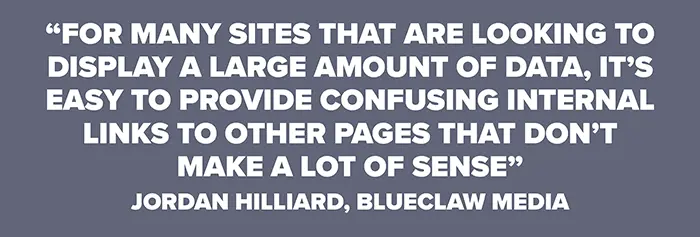

For affiliates operating in a highly competitive market like igaming, prioritising user experience is an important ranking factor that can help keep you ahead of your competitors. Jordan Hilliard presents some solutions to common issues affiliates may face in getting sites Page Experience-ready
An igaming affiliate site can boast high-quality and relevant onsite content and an authoritative backlink profile, but without prioritising a smooth user experience, its ranking potential will be limited. A great UX makes a real difference to how players engage with any site, which is particularly important for online casinos or affiliates that offer a mobile app.

From registration through to collecting winnings, igaming brands need to prioritise making the user journey within a desktop or app as seamless as possible in order to successfully attract, retain and expand their customers. Sites without a smooth UX – for example, those suffering from slow loading speeds or difficult-to-navigate search functions – will be at risk. Gamblers will simply abandon them and jump to a competitor’s site instead.
Many local markets still view online gambling products as solely money-making endeavours, as opposed to online entertainment experiences. With this in mind, it’s never been more important to ensure that any customer interaction is as seamless and positive as possible in order to be favoured in the SERPs and therefore stay ahead of your competition.
What is Google Page Experience?
Page experience refers to signals that measure how seamlessly a site user interacts with a web page. It’s a key consideration for both developers and SEO professionals as it focuses on accessibility, discoverability and efficiency in order to optimise a user’s site interactions.
In May 2020, Google announced a new ranking algorithm that judges web pages based on the quality of this user experience. This algorithm uses a new set of performance metrics known as Core Web Vitals, in order to gauge whether a site is easy for customers to navigate, and if it isn’t, why not. These Core Web Vitals are measured using real-world usage data and consist of the following:
- First Input Delay (FID) This refers to the length of time it takes for a web page to be ready for user interactivity, as it measures the time between a customer interacting with a web page and the browser starting to process the request. For a good UX, sites should aim for a First Input Delay of 100 milliseconds or less.
- Largest Contentful Paint (LCP) This is the time interval between the start of a page load to when the biggest image or text block is fully rendered. This metric only takes into account the content above the page’s fold, meaning everything that is visible without scrolling.
- Cumulative Layout Shift (CLS) This is the measured impact and distance fraction of the website layout shift which may see the content layout impaired by DOM manipulation or missing dimension attributes for media elements (images, videos). These unexpected layout shifts usually occur while the page is still downloading.
These page-level performance metrics are graded into the following categories: good (pass), needs improvement, and fail.
As well as considering Core Web Vitals, Google Page Experience also takes into account whether a page is mobile-friendly, whether it’s served over https (i.e. if it uses a secure connection), and if there are any intrusive interstitials.
Many brands operating in the igaming sector have one thing in common: their rankings are being negatively impacted by easily identifiable UX issues that remain unresolved on affiliate sites. This is particularly true among sportsbooks, which rely on a large quantity of data that can lead to overly complicated site navigation.
Rectifying UX issues should be a top priority for these brands, as sports betting is an increasingly competitive market and users can easily jump to a different provider to complete their transaction. And naturally, as affiliate sites, streamlining the user journey is key to maintaining a passive income via online casino compensation. But what are the common issues igaming affiliates face when it comes to Google Page Experience, and how can they be resolved?
Issue: Overly complex registration process
Among affiliate providers, enticing new customers is a key part of operating in the igaming sector. Online registration forms come in all shapes and sizes, meaning it’s easy to create one that is too long or complicated for the average player to complete. These complications may come in the form of too many text fields, too many pop-ups, or confusing float labels.
Solution: Keep it minimal and relevant
The easiest way to tackle registration process problems is to simplify the process and to focus solely on obtaining the information needed in order to use the site. Generally speaking, this would be the player name, email address and password, although igaming brands will naturally also require some ID or similar credentials, in line with local gambling laws. Some brands may also want to consider offering one-click registrations for existing customers.
Issue: Apps that aren’t mobile-friendly
One of the biggest appeals of online casinos and affiliate operators are their mobile apps. These allow players to place bets on their favourite games and events while they’re out and about. Yet many brands are falling into the trap of trying to replicate their desktop interface on a mobile app without taking into account differences in screen size, feature requirements or navigation.
Solution: Optimise mobile in tandem with desktop
For brands, it’s always best to create a desktop interface with mobile in mind from the beginning, so that there’s less work required to translate it across to an app. Make it clear which features should be shared across platforms (such as game categorisation, navigation bars and forms), and perform user testing on any concepts to determine which ones work, and which would be better removed from an app.

Issue: Lacking findability and confusing navigation
Sites that rely on a large quantity of data are more likely to experience navigation and categorisation issues, which can lead to frustrated customers unable to locate an online slot, casino provider or sports event. Some of the most common issues for findability, discoverability and navigation are poorly labelled menus, unclickable buttons and poor pop-out labelling.
Solution: Test discoverability early and often
When designing a new site, always make sure to check what your competitors are utilising and review current performance in order to decide what’s actually important to include – and how you should include it. Always stick to using tried-and-tested navigation features rather than creating something from scratch, and improve on this as you operate. And make sure to perform user testing as early in the process and as often as you can in order to continually identify areas of improvement.
Issue: Illogical transitions between web pages
For many sites that are looking to display a large amount of data, it’s easy to provide confusing internal links to other pages that don’t make a lot of sense – for example, prompting users to visit an online slots page when they’re reading a football article – which can lead to keyword stuffing and cannibalisation due to illogical link paths repeated across different pages.
Solution: Streamline relevant link paths
Make sure that you’re only providing internal links or clickable CTAs to pages or services that are relevant to the page a user is visiting. Also, avoid redirects as this will improve the authority and trustworthiness of your site. In short, each page should adhere to Google’s Search Quality Rating Guidelines to avoid being interpreted as spam. This is particularly important for sectors that can struggle with reputation issues, such as gaming.

Summary
Ultimately, providing a positive user experience that guarantees accessibility, findability and efficiency should be a top priority for affiliate brands to compete within a competitive igaming landscape. It’s no longer enough to offer attractive bonuses, a diverse profile of game titles or generous odds; users are increasingly becoming used to navigating responsive and attractive apps and sites, meaning any factors that impair their interactive experience will be tolerated less and less as time goes on.
However, it’s important to note that Page Experience isn’t the be-all and end-all when it comes to attracting a target audience. Here, Google still looks to rank pages that provide the best information overall, even if the UX is lacking. Page Experience doesn’t overrule having quality page content, and so optimising Core Web Vital factors should be a focus within a wider SEO strategy, rather than a standalone goal.
In order to evaluate how good the UX of your website is, you should undergo user testing for real-life insight into how users are interacting with your site, and also review conversion rates; if your conversion rates are high, the user experience is probably positive. For more information, you can consult Google’s Core Web Vitals and Page Experience FAQs, or take Google’s Mobile-Friendly Test.

Jordan Hilliard
is a senior SEO Lead at Blueclaw Media. With nearly five years’ SEO experience, Jordan has gained experience in a number of industries, with special focus on YMYL (Your Money, Your Life) sites and more recently on both operator and affiliate sites at Blueclaw.
Want to learn more affiliate marketing hacks to get you the best CPA/rev-share deals possible? Then you NEED to join us for Affiliate Meet Markt in Berlin on 26-27 Oct. And the best part... Affiliates attend for FREE.